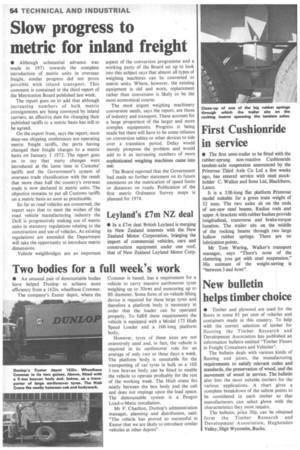Slow progress to metric for inland freight
Page 56

If you've noticed an error in this article please click here to report it so we can fix it.
• Although substantial advance was made in 1971 towards the complete introduction of metric units in overseas freight, similar progress did not prove possible with inland transport. This comment is contained in the third report of the Metrication Board published last week.
The report goes on to add that although increasing numbers of bulk metric consignments are being conveyed by inland carriers, an effective date for changing their published tariffs to a metric basis has still to be agreed.
On the export front, says the report, most deep-sea shipping conferences are operating metric freight tariffs, the ports having changed their freight charges to a metric basis on January 1 1972. The report goes on to say that many changes were introduced at the 'same time in Customs' tariffs and the Government's system of overseas trade classification with the result that more than half the country's overseas trade is now declared in metric units. The objective remains to put all Customs tariffs on a metric basis as soon as practicable.
So far as road vehicles are concerned, the report says that to meet the wishes of the road vehicle manufacturing industry the DoE is progressively making use of metric units in statutory regulations relating to the construction and use of vehicles. As existing regulations are amended the Department will take the opportunity to introduce metric dimensions.
Vehicle weighbridges are an important aspect of the conversion programme and a working party of the Board set up to look into this subject says that almost all types of weighing machines can be converted to metric units. Where, however, the existing equipment is old and worn, replacement rather than conversion is likely to be the most economical course.
The most urgent weighing machinery conversion needs, says the report, are those of industry and transport. These account for a large proportion of the larger and more complex equipments. Progress is being made but there will have to be some reliance on conversion tables or other devices to tide over a transition period. Delay would merely postpone the problem and would add to it as increasing numbers of more sophisticated weighing machines came into use.
The Board reported that the Government had made no further statement on its future intentions on the metrication of speed limits or distances on roads. Publication of the first metric Ordnance Survey maps is planned for 1974.
















































































































































































































